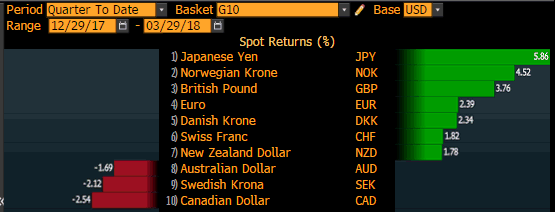By Kathy Lien, Managing Director of FX Strategy for BK Asset Management.
The first quarter of 2018 has officially drawn to a close and there have been some big swings in currencies over the last 3 months. The best performer was the Japanese yen, which soared against all of the major currencies, gaining over 5% in value versus the U.S. dollar. However its strength was most pronounced versus the Australian and Canadian dollars where a 7% move took AUD/JPY and CAD/JPY to their weakest levels in more than a year. These declines began in January but accelerated in February when U.S. stocks peaked and started to move sharply lower. There were a lot of big stories in the first quarter but the one that had the greatest impact on currencies was the end of bull market. However as stocks fell, investors did not always park their money in U.S. dollars. Instead, they bought euros and sterling as uncertainty stemmed from U.S. policy. The Canadian and Australian dollars were the worst performers. The loonie was hit by NAFTA concerns and dovish comments from the Bank of Canada while the Australian dollar fell on the back of risk aversion and growing trade tensions between the U.S. and China. We saw the same unevenness in the dollar’s performance March with euro and sterling outperforming commodity currencies.

Markets around the world are closed on Friday and while U.S. and Canadian markets reopen on Monday, Europe, Australia and New Zealand don’t return from their Easter holiday until Tuesday. This means that barring an unexpected tweet from President Trump, it should be relatively quiet. U.S. stocks rebounded strongly on Thursday but the gains failed to translate into strength for any major currencies. A large part of this has to do with month- and quarter-end flows. The latest U.S. economic reports were mixed. Weekly jobless claims dropped to its lowest level since 1973 as personal income and spending growth met expectations. Yet manufacturing activity in the Chicago region slowed more than expected and the University of Michigan Consumer Sentiment index was revised lower. Looking ahead, the most important release on next week’s calendar will be the March nonfarm payrolls report.
EUR/USD sold off for the third day in a row with the latest decline taking the pair below the 20- and 50-day simple moving averages. This is significant because it opens the door for a move down to 1.22. The sell-off was triggered by softer-than-expected German consumer price growth. The ECB has been slow to change forward guidance and this latest report reinforced their cautiousness. With that in mind, year-over-year CPI growth in Germany still accelerated from 1.4% to 1.6% while the unemployment rate fell to 5.3% from 5.4%. Softer data also pressured GBP/USD lower. House prices fell -0.2% in March according to Nationwide, while mortgage approvals dropped to 63.9K from 67.1K. There were no revisions to U.K. Q1 GDP growth and no news on Brexit. GBP/USD has significant support between 1.3985 and 1.40.
Meanwhile, the Canadian dollar was unfazed by weaker GDP growth. Throughout this week, we’ve talked about the loonie’s resilience and while USD/CAD jumped right after we learned that Canada’s economy contracted -0.1% in January, the first drop in 5 months, the rally was short-lived. Part of this may have to do with the recovery in stocks and the rebound in oil prices but the weakest year-over-year growth in 11 months should not be ignored. At minimum, it reinforces the Bank of Canada’s caution and reduces the chance of another rate hike in the next few months. The Australian and New Zealand dollars also traded higher on Thursday – AUD benefited from an increase in job vacancies while NZD/USD traders took comfort from a sizeable increase in building permits. With that in mind, the Reserve Bank of Australia, which meets next week, doesn’t have any particular reason to change its neutral guidance.
